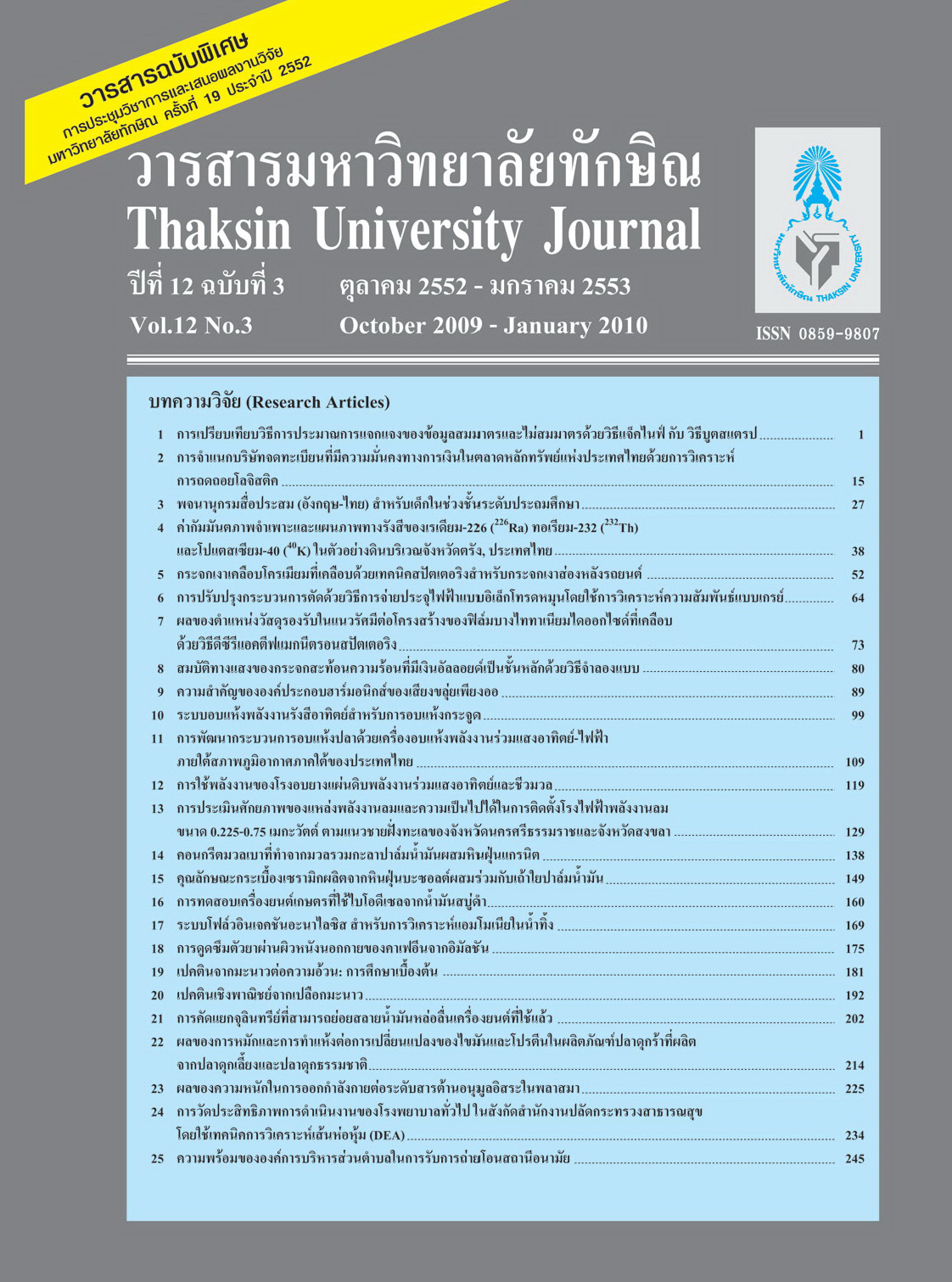การคัดแยกจุลินทรีย์ที่สามารถย่อยสลายน้ำมันหล่อลื่นเครื่องยนต์ที่ใช้แล้ว
Main Article Content
Abstract
การคัดแยกจุลินทรีย์ที่สามารถย่อยสลายน้ำมันหล่อลื่นเครื่องยนต์ที่ใช้แล้วโดยเก็บตัวอย่างดินที่ ปนเปื้อนน้ำมันในอำเภอหาดใหญ่ จังหวัดสงขลา ผลการศึกษาพบว่าสามารถแยกจุลินทรีย์ได้ 36 ไอโซเลท ได้แก่แบคทีเรีย 25 ไอโซเลท และยีสต์ 11 ไอโซเลท โดยยีสต์ไอโซเลท PO1.2 มีประสิทธิภาพในการย่อย สลายน้ำมันหล่อลื่นเครื่องยนต์ที่ใช้แล้วและสามารถสร้างสารลดแรงตึงผิวชีวภาพ (biosurfactant) ได้ดีที่สุด เมื่อศึกษาลักษณะสัณฐานวิทยา พบว่าโคโลนีของยีสต์ PO1.2 บนอาหาร YM agar มีลักษณะ สีขาวขุ่น ขอบเรียบ แบนราบ เมื่อนำไปพิสูจน์เอกลักษณ์ทางลำดับดีเอ็นเอ ด้วย 26S rDNA sequencing พบว่าเป็นเชื้อ Issatchenkia orientalis เมื่อนำ I.orientalis PO1.2 มาศึกษาประสิทธิภาพในการย่อยสลาย น้ำมันหล่อลื่นเครื่องยนต์ที่ใช้แล้ว ผลการทดลองพบว่าสามารถย่อยสลายน้ำมันหล่อลื่นเครื่องยนต์ที่ใช้แล้ว ได้ดีที่สุดที่ 0.5% ซึ่งจะให้ประสิทธิภาพในการย่อยสลายน้ำมันหล่อลื่นเครื่องยนต์ที่ใช้แล้ว 63.60 % นอกจากนี้ ยังพบว่าเชื้อ I. orientalis PO1.2 สามารถผลิตสารลดแรงตึงผิวชีวภาพ โดยเมื่อนำส่วนใสมาทดสอบกิจกรรมการ เกิดอิมัลชัน (Emulsification activity) โดยใช้น้ำมันถั่วเหลือง น้ำมันปาล์ม และน้ำมันรำข้าว พบว่า เชื้อ I. orientalis PO1.2 มีประสิทธิภาพการเกิดอิมัลชัน ต่อน้ำมันรำข้าวได้ดีที่สุดเท่ากับ 71.67 % ในอาหารที่มีการเติมน้ำมันหล่อลื่น เครื่องยนต์ที่ใช้แล้วความเข้มข้น 0.1% เป็นแหล่งคาร์บอน
Waste lubricating oil-degrading microorganisms were isolated from oil contaminated soil which collected from Hat Yai District, Songkhla Province. The isolation and screening of microorganisms that can degrade waste lubricating oil showed 36 isolates (bacteria 25 isolates and yeast 11 isolates). Isolate PO1.2 was the most active microorganism in the assimilation of waste lubricating oil and biosurfactant production. The isolated yeast strain, PO 1.2 was characterized on YM agar plate as followed: growth at 30 oC, off-white color, smooth with margins ranging from smooth to lobed, and flat. Determination of the nucleotide sequence of the gene encoding 26S rDNA of the isolate PO1.2 was identified as Issatchenkia orientalis. I. orientalis PO1.2 showed the best degrading activity was 63.60% when waste lubricating oil was 0.5%. In addition, I. orientalis PO1.2 can produce biosurfactant. Determination of emulsification activity (%EA) from I. orientalis PO1.2 with soy bean oil, palm oil or rice bran oil, the result showed the best %EA with rice bran oil (71.67%) when used 0.1% waste lubricating oil as a carbon source.


